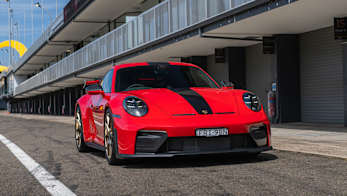Since 2017, the Chrysler 300 SRT has been a hallmark of police pursuit fleets in Australia, and to many, one of the few ways to get behind the wheel of a V8 performance sedan at a much lower price than is offered at the premium end of the market. Now, though, that looks to all be over.
In fact, your last opportunity to buy a brand-new SRT Down Under may have already passed. At the time of writing, quickly looking through all listings in Australia shows just 12 brand-new 3.6-litre V6 300C sedans on sale, and zero SRT V8s.
To add to this, the Chrysler 300 is not mentioned once in the H2 results presentation of the brand's new owner, Stellantis, with Chrysler only mentioned in passing for the performance of the Pacifica people mover, which is now positioned as the third best-selling PHEV in America.
.jpg)
In contrast, the global success of Ram is mentioned multiple times, and the brand laid bare its aggressive electrification timelines for its plethora of European marques. Even Fiat is performing well thanks to its new 500 EV and Strada monocoque ute sold in South America.
Importantly, a slide from the Stellantis H1 presentation which boasts of its 21 planned hybrid and EV launches for the next two and a half years, the Chrysler column is entirely bare.
Earlier this year, it was apparent the writing was on the wall for the V8 muscle sedan, as the rumour mill began to circulate in Australia that dealers could no longer order examples of the car, and that constraints had put the brakes on production altogether.
It was later reported that Chrysler branding was not a part of Stellantis’ Australian dealer showroom designs, and dealers were reporting the available stock of new cars in 2021 was it.
Chrysler has a contract in place to provide the NSW Highway Patrol with 300 SRTs until the end of the year alongside their BMW 530d alternatives, and the Australian arm of the group hasn’t offered comment thus far on wrapping up poorly performing nameplates with limited future prospects for our market since becoming Stellantis.
.jpg)
Fiat, for example, looks to be on dire straits in Australia, with no plans thus far to bring the popular-in-Europe battery-electric 500 hatch to our market, and there's no replacement for the discontinued Jeep Renegade-based 500X small SUV in sight.
This leaves Stellatis' factory-backed hopes in Australia seemingly firmly pinned on Jeep and Peugeot, with the remarkably successful Ram being brought to Australia by the independent Ateco group.
According to its H1 financial results presentation, Stellantis is full steam ahead on the electrification of its core range internationally. Alfa Romeo is set to become 100 per cent battery electric in 2027 and Citroen’s premium arm, DS, is set to become fully electric by 2024.
Don’t count Chrysler out forever, though. While things are looking poor for the brand now, Stellantis is in the process of reviving the also near-dead Lancia, with new products planned for as far out as 2026. Group CEO Carlos Tavares said the Stellantis has no plans to discontinue any of the brands under its umbrella.
Could Chrysler be remade as something different before the end of the decade? Time will tell.













.jpg)

.jpg)
.jpg)


.jpg)

.jpg)

.jpg)
.jpg)
.jpg)



.jpg)
